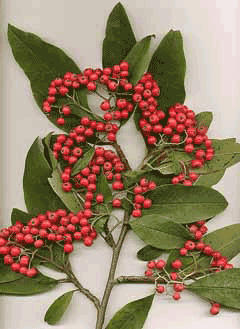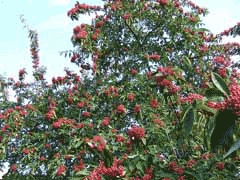 |
|
http://en.wikipedia.org/wiki/User:MPF |
 |
| http://en.wikipedia.org/wiki/User:MPF |
Translate this page:
Summary
Physical Characteristics

 Cotoneaster frigidus is a deciduous Shrub growing to 10 m (32ft) by 10 m (32ft) at a fast rate.
Cotoneaster frigidus is a deciduous Shrub growing to 10 m (32ft) by 10 m (32ft) at a fast rate.
See above for USDA hardiness. It is hardy to UK zone 7. It is in flower in June, and the seeds ripen from September to November. The species is hermaphrodite (has both male and female organs) and is pollinated by Flies, midges.
It is noted for attracting wildlife.
Suitable for: light (sandy), medium (loamy) and heavy (clay) soils, prefers well-drained soil and can grow in heavy clay and nutritionally poor soils. Suitable pH: mildly acid, neutral and basic (mildly alkaline) soils and can grow in very alkaline soils.
It can grow in full shade (deep woodland) semi-shade (light woodland) or no shade. It prefers dry or moist soil. It can tolerate atmospheric pollution.
UK Hardiness Map
US Hardiness Map
Synonyms
Plant Habitats
Woodland Garden Dappled Shade; Shady Edge; not Deep Shade; Hedge;
Edible Uses
References More on Edible Uses
Medicinal Uses
Plants For A Future can not take any responsibility for any adverse effects from the use of plants. Always seek advice from a professional before using a plant medicinally.
Blood tonic
The fruits are eaten to replenish the blood in cases of deficiency[272].
References More on Medicinal Uses
The Bookshop: Edible Plant Books
Our Latest books on Perennial Plants For Food Forests and Permaculture Gardens in paperback or digital formats.

Edible Tropical Plants
Food Forest Plants for Hotter Conditions: 250+ Plants For Tropical Food Forests & Permaculture Gardens.
More

Edible Temperate Plants
Plants for Your Food Forest: 500 Plants for Temperate Food Forests & Permaculture Gardens.
More

More Books
PFAF have eight books available in paperback and digital formats. Browse the shop for more information.
Shop Now
Other Uses
References More on Other Uses
Cultivation details
An easily grown plant, it prefers a good soil but also does well in poor soils[1, 11, 200]. It thrives in lime and is also happy in peaty soils[1]. It succeeds in any soil that is not marshy or waterlogged[11, 200]. Succeeds in dry soils[188]. Grows well in heavy clay soils. Succeeds in full sun or semi-shade but does not fruit so freely in a shady position[11, 200]. Plants also succeed in quite deep shade[219]. Tolerates atmospheric pollution[200]. A fast-growing plant[219]. The flowers, when inhaled near to, have an unpleasant smell like decaying fish[245]. They are very attractive to bees whilst the fruit is a good winter food source for many species of birds[200]. Hybridizes freely with other members of this genus, especially those species in the 'Salicifolia' group of this genus[182]. Trees are notably susceptible to honey fungus[200].
References Carbon Farming Information and Carbon Sequestration Information
Temperature Converter
Type a value in the Celsius field to convert the value to Fahrenheit:
Fahrenheit:
The PFAF Bookshop
Plants For A Future have a number of books available in paperback and digital form. Book titles include Edible Plants, Edible Perennials, Edible Trees,Edible Shrubs, Woodland Gardening, and Temperate Food Forest Plants. Our new book is Food Forest Plants For Hotter Conditions (Tropical and Sub-Tropical).
Shop Now
Plant Propagation
Seed. Members of this genus hybridize freely so, if you require seed that breeds true, it is important to obtain it from a known wild source or from a controlled fertilization of garden plants. The seed is best sown as soon as it is ripe in the autumn in a cold frame, when it will usually germinate in the spring[11, 200]. Stored seed germinates faster if given 3 months warm stratification at 15°c and then 3 months cold stratification at 4°c[164]. The seed usually germinates within 1 - 18 months at 15°c but it can take 2 years[164]. Pot the seedlings up as soon as they are large enough to handle and plant them out into nursery beds or into their permanent positions when they are more than 10cm tall. Cuttings of half-ripe wood with a heel, July/August in a frame[11, 200].
Other Names
If available other names are mentioned here
Native Range
TEMPERATE ASIA: China (Xizang Zizhiqu) TROPICAL ASIA: Bhutan, India (Himalayan region), Nepal
Weed Potential
Right plant wrong place. We are currently updating this section.
Please note that a plant may be invasive in one area but may not in your area so it's worth checking.
Conservation Status
IUCN Red List of Threatened Plants Status :

Growth: S = slow M = medium F = fast. Soil: L = light (sandy) M = medium H = heavy (clay). pH: A = acid N = neutral B = basic (alkaline). Shade: F = full shade S = semi-shade N = no shade. Moisture: D = dry M = Moist We = wet Wa = water.
Now available:
Food Forest Plants for Mediterranean Conditions
350+ Perennial Plants For Mediterranean and Drier Food Forests and Permaculture Gardens.
[Paperback and eBook]
This is the third in Plants For A Future's series of plant guides for food forests tailored to
specific climate zones. Following volumes on temperate and tropical ecosystems, this book focuses
on species suited to Mediterranean conditions—regions with hot, dry summers and cool, wet winters,
often facing the added challenge of climate change.
Read More
Expert comment
Author
Wall. ex Lindl.
Botanical References
1151200
Links / References
For a list of references used on this page please go here
Readers comment
| Add a comment |
|
If you have important information about this plant that may help other users please add a comment or link below. Only comments or links that are felt to be directly relevant to a plant will be included. If you think a comment/link or information contained on this page is inaccurate or misleading we would welcome your feedback at [email protected]. If you have questions about a plant please use the Forum on this website as we do not have the resources to answer questions ourselves.
* Please note: the comments by website users are not necessarily those held by PFAF and may give misleading or inaccurate information.
To leave a comment please Register or login here All comments need to be approved so will not appear immediately.
|
Subject : Cotoneaster frigidus
|
|
|
|